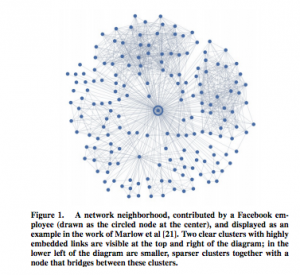Modeling the Dispersion of Network Ties Based on Relationship Status on Facebook
When analyzing the distances between users in an online network, connections among users on social networking sites such as Facebook and Twitter can offer insights into the ways, and how often, people interact in real life. One of the most interesting ways in which an individual users network expands is through engaging another user in a romantic relationship on Facebook — the relationship status two networks with varying levels of mutal connections merge. In 2013, Cornell computer scientist Jon Kleinberg published a paper with engineers at Facebook investigating how strong real-world ties, such as a romantic partner or best friend, can be identified in online social media networks based on the strength and distance between ties in the network. Such analysis can be used to not only identify close friends and partners, but also to determine the probability of breakups in the relationships modeled by the ties.
These findings point to a new metric in measuring the tie strength in graph theory. Traditionally, embeddedness and closure are the primary characteristics used to categorize strong and weak ties in a network. Instead, Kleinberg’s team proposes that dispersion between clusters in a network may be a more useful metric for using tie strength to identify close relationships, such as romantic partnerships. Dispersion is measure of the distance between the mutual friends (who are weakly connected) when looking at the link between two people. High dispersion indicates that the mutual friends between two people are not well-connected to each other. When incorporating the dispersion metric into an algorithm to identify romantic partners in a user’s Facebook network, the algorithm was able to accurately identify the romantic partner in 60 percent of cases.
Overall, Kleinberg’s contribution points to the multifaceted nature of modeling online networks with a real-world base. Family members and romantic partners, as dispersion indicates, can not only have a large number of mutual connections with a person, but those mutual ties can themselves be diverse and poorly connected to one another without diminishing the tie strength between close friends, family members, or lovers.
References:
Backstrom, Lars, and Jon Kleinberg. “Romantic partnerships and the dispersion of social ties: a network analysis of relationship status on facebook.” Proceedings of the 17th ACM conference on Computer supported cooperative work & social computing. ACM, 2014. Retrieved from http://delivery.acm.org/10.1145/2540000/2531642/p831-backstrom.pdf?ip=128.84.125.162&id=2531642&acc=OA&key=7777116298C9657D%2EB493315FA1EC298D%2E4D4702B0C3E38B35%2E528920FC4509E774&CFID=661557791&CFTOKEN=77778829&__acm__=1474082474_29a6fbf617df3a6cbb0c48dfbc312f42.

